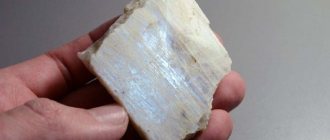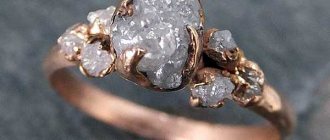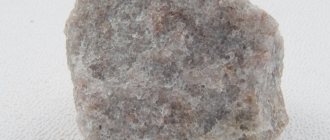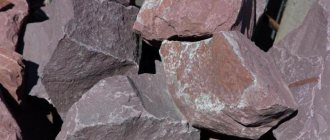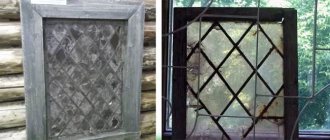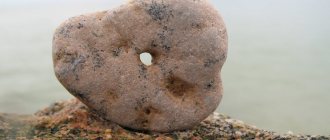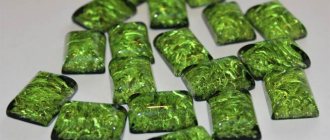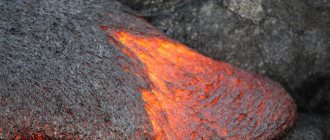Among the many rocks on Earth, the main group consists of igneous ones, which were formed over millions of years in the thickness of the earth’s crust from volcanic lava. These breeds include one of the main
building materials - granite. The properties of this stone have long been studied by people. This led to it being widely used in construction in the past, and it is still used today. A huge number of monuments and structures of antiquity have survived to this day due to the fact that they were made of granite. Its unique composition, beautiful granular structure and beneficial properties make this stone a very popular building material.
Granite deposits
This rock is formed as a result of the solidification of magma at great depths. It is affected by high temperature, pressure, gases and vapors rising from the thickness of the earth's crust. Under the influence of these factors, such a unique structure is obtained, the play of light and shadow that we observe in this stone. Most often it is gray in color, but sometimes red or green granite is mined. Its properties depend on the size of its constituent grains. It can be coarse-grained, medium-grained and fine-grained (the most
lasting).
This rock usually lies at great depths, but sometimes comes to the surface. Granite deposits are found on all continents and in almost all countries, but most of them are in Siberia, Karelia, Finland, India and Brazil. Its extraction is quite expensive, since it occurs in the form of huge layers, often extending for several kilometers.
History and origin
One lyricist in his poems associated granite with the words “edge” and “boundaries”, but the name of the stone arose from the Latin granum - “grain” . The name of the mineral was given by the Italian naturalist Caesalpinus. But the first information about the rock itself was recorded in documents from the times of Ancient Egypt and Rome. Then people used the material in the construction of fundamental structures.
Granite is often associated with strength and reliability. It makes up most of the earth's crust. There are even entire mountains made from this rock, for example, Mont Blanc. The stone is called the “calling card of the Earth” because it is not found on other planets.
Scientists give two versions of the origin of granite. Some experts believe that natural stone arose from molten magma, which slowly cooled in the earth's crust. Over time, it formed into a fossilized structure, and over many years, granite grains of various sizes crystallized in it.
Other scientists are inclined to believe that sedimentary rocks with sand and types of clay gradually shifted due to tectonic processes deep in the earth's crust. High temperatures and pressure caused the substances to melt. This process was called granitization.
Most of the world's granites are formed in collision zones. When two continental plates collide with each other, the layer of crust on the continent increases. Due to thickening, layered deposits of molten rock appear at a depth of 10−20 km. This phenomenon is called granitic magmatism.
Basic properties of granite
The advantages of this stone allow us even now to admire the architectural structures made from it in ancient times. What properties of granite determine its widespread use?
1. Durability. Fine-grained varieties of granite show the first signs of abrasion only after 500 years. Therefore, it is sometimes called the eternal stone.
2. Durability. Granite is considered the most durable substance after diamond. It is resistant to compression and friction. This is explained by the properties of quartz included in its composition. In addition, it becomes clear why this rock is so strong once the answer to the question of what is the density of granite is found. It is actually very high - almost three tons per cubic meter.
3. Weather resistant. Granite can withstand temperatures from minus 60 to plus 50 degrees Celsius. This is very important in cold climates. Research has proven that granite products do not lose their properties after freezing and thawing 300 times.
4. Waterproof. It is thanks to this property that granite is so
frost-resistant. Therefore, it is ideal for cladding embankments.
5. Environmental cleanliness. Granite is not radioactive at all and is therefore safe for any construction work.
6. Fire resistance. This material begins to melt only at 700-800 degrees Celsius. Therefore, lining a house with it is not only beautiful, but also safe.
7. Ease of processing, compatibility with any building materials and a wealth of textures and colors make it indispensable for interior design.
8. Resistance to acids and fungi.
Stone in the history of civilization
Granite buildings have been preserved since Antiquity and Ancient Egypt.
The most famous buildings:
- obelisk in honor of the Egyptian goddess Hatshepsut;
- the national pride of Spain, El Escorial;
- Lenin's Mausoleum in Moscow.
Lenin's Mausoleum in Moscow
Amazonite granite is mentioned by Herodotus and Pliny. They connect him with the warlike tribe of Amazons who lived in the territory of ancient Scythia. Household items, jewelry, and weapons were made from stone.
St. Petersburg is built from granite: the buildings of the Academy of Arts, the Admiralty, St. Isaac's Cathedral, the Alexandrian Column. The pedestal of the city’s symbol, the Bronze Horseman, and the facing of the Neva embankment are made of stone, which was captured by the great Pushkin in the poem “The Bronze Horseman”: “The Neva is dressed in granite.”
Granite processing
Despite the strength and high density of the rock, this stone is easy to process. It is quite easy to cut and polish. Typically, large granite blocks, slabs or granite chips and crushed stones are sold. It is used to make tiles, countertops and paving stones. The richness of textures of this natural stone makes the use of granite acceptable for decorating any interior. Untreated stone looks very beautiful, absorbing light well. Polished to a shine, it reveals all its virtues and the beauty of mica inclusions. When processing the rock using the chipping method, a relief structure is obtained with a decorative effect of play of chiaroscuro. And some types of gray granite become milky white after heat treatment.
The magical powers of the stone
Even ancient magicians and sorcerers noticed the importance of granite as a protector from dark forces and unkind people. No wonder the chambers of rulers and nobility were decorated with this stone.
This property is still relevant today. It is complemented by new qualities identified by esotericists.
- This is the stone of all who teach and “gnaw the granite of science.” It will help teachers cope with the audience and convey knowledge as clearly and accurately as possible. Students can learn more deeply, present information, and remember better. Just be smarter.
Color has meaning:
- A red stone can make a person intuitive, develop intelligence and speed of reaction. At the same time, enhance creativity and find innovative solutions.
- Yellow varieties are indicated for authoritarian, ambitious people, so as not to get carried away.
- The magic of gray granite changes life for the better on all levels: work, finances, love/family, place of residence.
Granite rock of any shade cleans the room of negative energy and makes a person more sociable. This talisman is suitable for shy natures.
Types of granites
Based on what minerals are included in granite, it is especially worth paying attention to dark-colored components. These rocks are divided into several groups: alaskite, leucogranite, biotite, pyroxene, alkaline and others. These breeds also differ in structure:
— porphyritic granite, which contains elongated inclusions of minerals;
— pegmatoid — characterized by uniform grain size of quartz and feldspar;
— gneiss-like is a uniform, fine-grained stone;
- Finnish granite, which is also called rapakivi, has round inclusions of red color;
- written - a very interesting variety, in it the particles of feldspar are arranged in the form of wedge-shaped strips, similar to ancient writing.
Recently, artificial granite, created by firing clay with minerals, has also been used. This stone is called porcelain stoneware and is almost as good in properties as natural stone.
Types and colors of stone
The different components that make up the stone, as well as their concentration, determine a wide range of color options. The most famous is gray (light or dark gray shades). Other shades:
- pink;
- lilac;
- orange;
- yellow;
- red;
- blue;
- blue;
- green;
- beige;
- brown;
- white;
- black.
Black gabbro granite has a special texture. When processed, you can get a perfectly smooth shiny surface. Granite stone has various patterns - spots, inclusions, striped-wavy patterns, rings.
Geochemical classification of the White and Chappell granitoids
Types of stone in terms of geochemical aspects:
- S – product of melting of metasedimentary rocks;
- I – the result of melting of metamagma substrates;
- M – formed from magmas containing tholeiitic and basaltic rocks;
- A – consists of incoherent chemical elements.
Classification by grain structure
Based on grain structure, they are distinguished:
- Porphyritic. There are protruding long inserts of quartz, microcline, and orthoclase.
- Pegmatoid. A uniformly grained stone with a symmetrical arrangement of grains.
- Rapakivi. Finnish granite stone. It has red round inserts with a gray frame.
- Gneissic. A classic specimen characterized by a fine-grained texture.
Names of stones based on mineral composition
According to mineral composition:
- Alaskite – dark-colored minerals are absent.
- Leucogranite – there are few dark colors.
- Biotite – the content of this mineral in the stone reaches 6–8%.
- Double-mica granite contains both biotite and muscovite.
- Lithium fluoride – the composition contains lithium mica.
- Alkaline – a large percentage of alkaline compounds.
- Pyroxene – content of orthoclase, quartz, augite.
Types of breed by color
The properties and uses of granite also depend on its color. Based on this trait, several breed groups are distinguished:
— amazonite granite, due to the green feldspar it contains, has a pleasant bluish-green color;
- pink-red and red Leznikovsky - the most durable;
- gray rocks are very common, and they got their names from the places of extraction: Korninsky, Sofievsky, Zhezhelevsky;
— white granite is rare. This variety includes colors ranging from pale green to pearl gray.
Granite mineral: composition, properties, formula and description
Composition of granite rock
Granite is a unique mineral of igneous origin.
It is rich in silica and includes the following components:
- potassium feldspar;
- acidic plagioclase;
- quartz;
- mica (biotite or muscovite);
- amphibole;
- pyroxene (very rare).
There are many elements that the structure of granite contains. The composition of individual specimens may vary. It happens that the rock contains minor inclusions.
This series includes graphite, tourmaline, talc, and iron mica. Therefore, for ease of study, the average chemical composition of granite was derived.
Granite formula
Scientist P. Daly presented it in the form of a long formula reflecting the percentage of elements: SiO2-70.18; Al2O3-14.47; K2O-4.11; Na2O -3.48; CaO - 1.99; FeO-1.78; Fe2O3-1.57; H2O-0.84; TiO2 - 0.39; MnO - 0.12; MgO - 0.88; P2O5- 0.19. From this point of view, the following types of granite are distinguished: potassium, potassium-sodium and soda.
The characteristics of granite classify it as a mineral with a crystalline granular structure.
Depending on the conditions in which the natural origin of granite occurred, different types of mineral structure are formed.
Coarse- and medium-grained specimens arise during slow cooling, when the crystallization processes are complete and complete. When the magma cools quickly, fine-grained glassy crystals emerge.
The description of granite may contain such definitions of stone as microlite, when there are empty cavities between the grain crystals, and cellular (druze).
Cellular does not contain spaces between the grains - they are filled with various inclusions. This is also a consequence of the formation conditions of the rock.
Applications of granite
This stone has been used in construction and facing work for many centuries. This is due to the fact that its fine-grained varieties begin to collapse only after 500 years. It is resistant to various impacts and very durable. These basic properties of granite allow it to be widely used in construction. Where is the mineral used:
1. Most of the monuments are made from it.
2. Its strength and abrasion resistance allow the stone to be used for making steps, flooring, porches and even pavements.
3. In cold climates, the most popular building material is granite. Its properties make it possible to cladding buildings and even embankments where
There are harsh winters.
4. This stone can transform your home both inside and out. Designers successfully use it to make columns, stairs, baseboards, countertops and railings. They also line the walls of houses.
5. The use of granite in swimming pools, bathrooms and fountains is due to the fact that it does not allow water to pass through at all. And also does not collapse under its influence.
Physico-chemical characteristics
To a chemist, granite is an acidic rock. Acidity depends on the amount of silicon dioxide. The more it is, the lighter the color of the granite.
| Rock type | Igneous rock |
| Color | light grey, pink, red, yellow, greenish |
| Texture 2 | massive porphyry |
| Structure 2 | fine-grained medium-grained coarse-grained |
| origin of name | from granum - grain |
Granite in the interior
In recent years, this stone has become very widely used for interior decoration. It goes well with all materials: wood, metal and ceramics - and is suitable for the design of any home. In addition to wall and floor cladding, granite can be used in many areas of the apartment. Its properties make this stone indispensable for making window sills and countertops in the kitchen. They are easy to care for, durable and do not deteriorate from exposure to moisture and high temperature.
Granite is also widely used in landscape design. A path or gazebo lined with this stone will not be afraid of atmospheric influences and will not crack over time. Flower beds designed by him, for example, in the style of a Japanese rock garden or in the form of a terrace, look beautiful. It is also very convenient to use granite for making borders and stairs.
The properties and uses of this stone have been studied for a long time. And it has been used by man since ancient times. With the advent of new processing technologies, granite began to be used even more often, because it became possible to improve its decorative properties.
How to care for granite
Natural granite is not very vulnerable, but you need to take care of it:
- Countertops, window sills, floors are washed with ordinary detergent.
- To maintain the polishing of the surface, do not wipe it with abrasives and powder detergents.
- To prevent dirt, dust, and especially food debris from clogging the pores of natural stone, the surface is treated with wax polishes. The resulting film will simultaneously protect against mold, mildew, and plaque.
If repairs are to be made, it is better to cover the surface with cling film or other film in advance. But if paint does get in, it is removed with strong cleaners for stone products. They also get rid of layers of fat and soot.
Caring for artificial stone is similar. And chips and cracks are eliminated with an acrylic filling compound.
